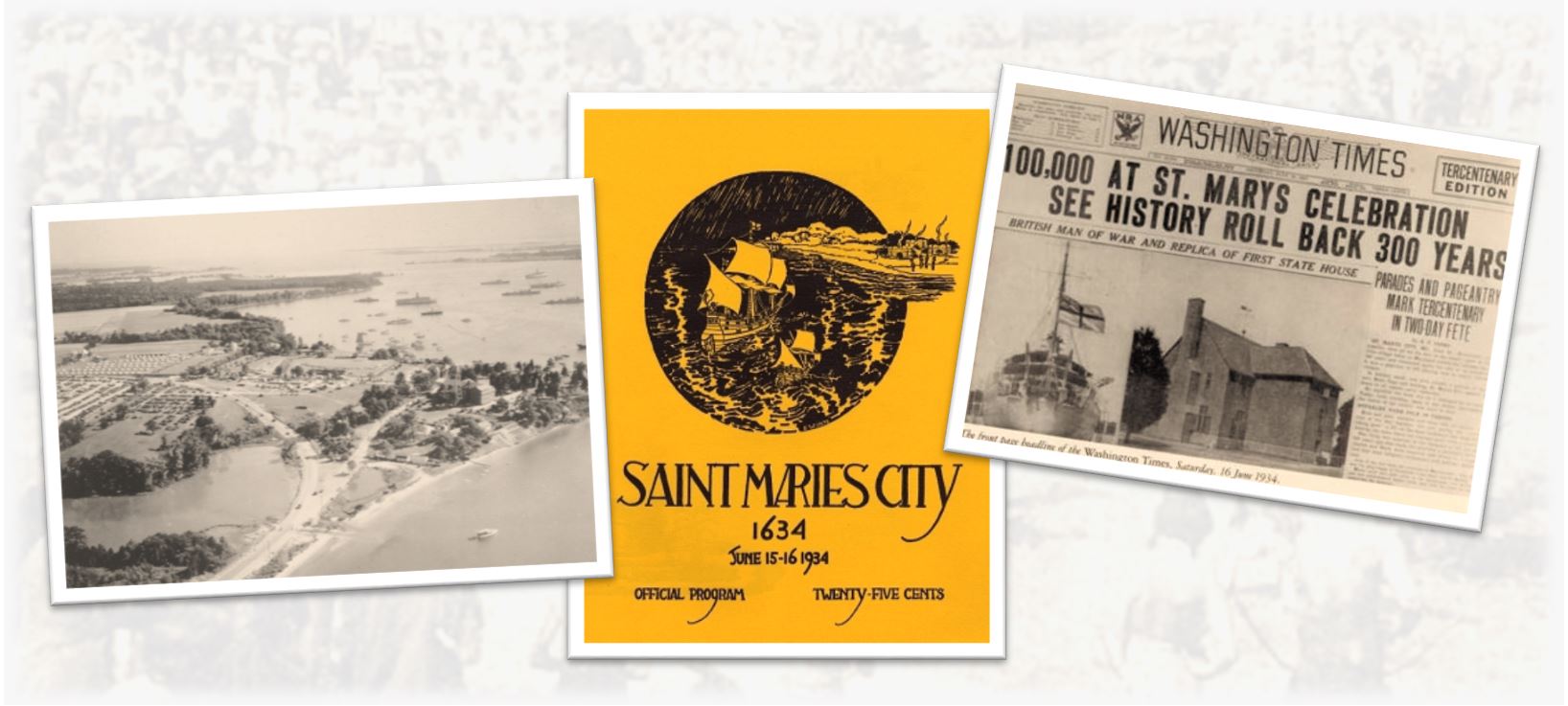The Tercentennial Celebration
Celebrating our Past Celebrations: The 1934 “Pageant” at St. Mary’s City
When Maryland celebrated the three hundredth anniversary in 1934, it was not the first celebration of the past at St. Mary’s City. The Georgetown University Philodomic Society ventured to St. Mary’s in 1852, the Calvert monument was erected in 1890, and a celebration of the 275th anniversary was held in 1909.
The Tercentennial Commission was established in 1927 by Governor Ritchie.
Illustrious members included: William Marbury, Mathew Page Andrews, Swepson Earle, and R. Bennett Darnall.
November 22, 1933 – Commemoration included placing a plaque at Cowes on the Isle of Wight in England, from which the Maryland colonists embarked, on the date they had sailed. This was “simulcast” with a parallel ceremony in Baltimore at the War Memorial Building. Part of the celebration included a Presidential radio address by FDR.
“It is a good thing to demand liberty for ourselves and for those who agree with us, but it is a better thing and rarer thing to give liberty to others who do not agree with us. We would do less than our duty to Lord Baltimore if on such an anniversary we paid no tribute to this, his greatest contribution to America, a free America. May we, in our own fights for things which we know to be right, fight as ably and as successfully as he did 300 years ago. For we have our own fights to wage not against the same foe which he beat down, but against other foes just as obstinate and just as powerful and just as intolerant of things we fight for today.”
Franklin D. Roosevelt 1933
March 25, 1934 –On Maryland Day, the celebration was focused at St. Clements Island where a large cross was erected. The celluloid button is from the Lettie Marshall Dent collection at the St. Mary’s County Historical Society.
National and Statewide Celebration
1934 included a national celebration featuring special U. S. postage stamps, the first commemorative license plates, a specially minted half dollar, and a Tercentennial medallion by Hans Schuler.
The Tercentennial medallion by Hans Schuler included the image of Gov. William Ritchie. He served as governor of Maryland from 1920 -1935.
The Tercentennial Reconstruction
Initial commemoration plans for St. Mary’s City included construction of a stone exedra or temple at Church Point, but difficulties obtaining permission from vestry of Trinity Church delayed action.
The Howards and the Bennetts offered to donate 1.18 acres of land with stipulations. The first stipulation was that the stone excedra be dropped as the memorial.
The other stipulation – rebuild the State House of 1676 following the specifications from the Maryland Archives.
An Act for the building of a State House and Prison at St Maries
“…to be built of brick or stone with lime & sand and to be Covered with Slate or tile laid in Morter and to be of these demencons (vizt) the said State house to be two Stories high and to Continue in length forty five foote from outside to outside with a porch in front sixteene foote Long and twelue foote broad in the Clear on the Inside and a staire case over against the Porch on the other side sixteene foote Square in the Cleere on the inside the first story of the said house Porch and staire Case to be twelue foote from the topp of the floore which shall be paved with flatt paveing Stone or Brick to the lower side of the summer and the second story to be Nine foote in the Cleere from the upper side of the board to the lower side of the summer the walls of the said house Porch and staire case to be built vppon a good secure and sound foundacon of twenty-eight inches thick from the bottom of the said foundacon to the water table which shall be three foote Cleere aboue ground”.
While the Assembly records had most of the information, the architects needed one additional dimension. Herbert S. Ragland, an archaeologist from Colonial Williamsburg, was hired to “take charge of a gang of local men” and find the missing dimension. We know about this because of a record that he was paid $172.88.
The State House architects were Herbert C. Crisp and James R. Edmonds and Horace W. Peasley’s firm designed landscaping and grounds.
Construction was under the supervision of G. Walter Tovell and cost $31,000 in 1934 which equals roughly $465,000 today.
| The bricks for the reconstruction of the State House came from Bushwood Manor and Carthagena, both of which had recently burned. |
Rose Greeley, a very significant early female landscape architect, working with Horace W. Peasley, planned the landscape- not all of her plan was executed.
Events at St. Mary’s City were held on June 15th and 16th 1934. The program included dedication of the State House, a Historical Pageant, and a Water Pageant.
The Water Pageant was directed by Swepson Earle who had been the head of the Maryland Conservation Police.
They rebuilt replicas of the Ark and Dove. The schooner May Brown was reworked to the Ark. The work was done at the Hartge boatyard in Galesville. US Naval destroyers USS Manley and USS Overton participated as did foreign naval vessels including the HMS Dundee.
St. Maries, Mother of Maryland, written and directed by Kathleen Read Coontz.
The pageant had seven episodes. Coontz also authored historical pageants on Lincoln and Washington.
A copy of the pageant script with dedication by Kathleen Read Coontz to Lettie Marshall Dent.
Dent, who portrayed Margaret Brent, was superintendent of schools for St. Mary’s County and the first woman to hold such a role in Maryland.
![]() Continue to Dig into the 1934 Tercentennial Celebration.
Continue to Dig into the 1934 Tercentennial Celebration.




































































